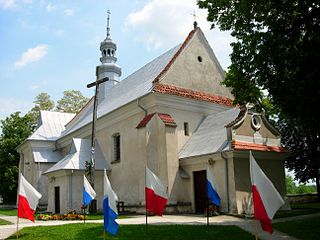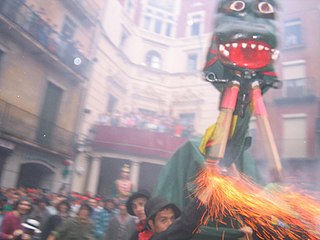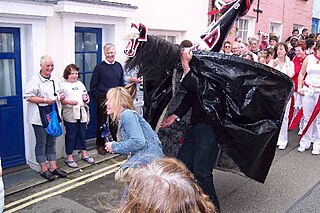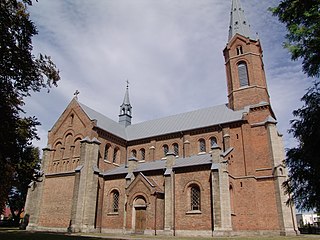
Lesser Poland, often known by its Polish name Małopolska, is a historical region situated in southern and south-eastern Poland. Its capital and largest city is Kraków. Throughout centuries, Lesser Poland developed a separate culture featuring diverse architecture, folk costumes, dances, cuisine, traditions and a rare Lesser Polish dialect. The region is rich in historical landmarks, monuments, castles, natural scenery and UNESCO World Heritage Sites.

Henry II the Pious was Duke of Silesia and High Duke of Poland as well as Duke of South-Greater Poland from 1238 until his death. Between 1238 and 1239 he also served as regent of Sandomierz and Opole–Racibórz. He was the son of Henry the Bearded and a member of the Silesian Piast dynasty. In October 2015, the Roman Catholic Diocese of Legnica opened up his cause for beatification, obtaining him the title of Servant of God.

Leszek II the Black, was a Polish prince of the House of Piast, Duke of Sieradz since 1261, Duke of Łęczyca since 1267, Duke of Inowrocław in the years 1273-1278, Duke of Sandomierz and High Duke of Poland from 1279 until his death.

Sandomierz is a historic town in south-eastern Poland with 23,863 inhabitants, situated on the Vistula River near its confluence with the San, in the Sandomierz Basin. It has been part of Świętokrzyskie Voivodeship since its transfer from the Tarnobrzeg Voivodeship in 1999. It is the capital of Sandomierz County. Sandomierz is known for its preserved Old Town, a major cultural and tourist attraction which the President of Poland declared a National Monument of Poland in 2017.

St. Mary's Trumpet Call is a traditional, five-note Polish bugle call closely bound to the history and traditions of Kraków. It is played every hour on the hour, four times in succession in each of the four cardinal directions, by a trumpeter on the highest tower of the city's Saint Mary's Basilica. The noon performance is broadcast via radio to all of Poland and the world.

Zawichost is a small town in Sandomierz County, Świętokrzyskie Voivodeship, Poland. It is located by the Vistula River in Lesser Poland, near Sandomierz. It is first mentioned in historical documents from around 1148. In 1205 the Battle of Zawichost was fought nearby. In 1241, 1259 and 1287 the town was ravaged by Mongol raids. Granted town rights before 1255, in the late Middle Ages it was one of the most important urban centers of Lesser Poland.

Tyniec is a historic village in Poland on the Vistula river, since 1973 a part of the city of Kraków. Tyniec is notable for its Benedictine abbey founded by King Casimir the Restorer in 1044.

The Patum de Berga, or simply La Patum, is a popular and traditional festival that is celebrated each year in the Catalan city of Berga (Barcelona) during Corpus Christi. It consists of a series of "dances" by townspeople dressed as mystical and symbolic figures, and accompanied either by the rhythm of a drum—the tabal, whose sound gives the festival its name—or band music. The balls are marked by their solemnity and their ample use of fire and pyrotechnics.

The 'Obby 'Oss festival is a folk custom that takes place each 1st of May in Padstow, a coastal town in North Cornwall. It involves two separate processions making their way around the town, each containing an eponymous hobby horse known as the 'Obby 'Oss.

Połaniec is a town in Staszów County, Świętokrzyskie Voivodeship, Poland, with 8,406 inhabitants (2012). The town is in Lesser Poland, and its history dates back to the early days of Polish statehood. It lies in the western part of the Sandomierz Basin, a few kilometres north of the Vistula, along the National Road Nr. 79, from Bytom to Warsaw. The town has a railway station serving a secondary line, nr. 75 from Rytwiany to Połaniec.

Talabuga Khan, also known as Tulabuga, Talubuga and Telubuga, was from 1287 to 1291 the Khan of the Golden Horde, a large, independent empire and one of the four successor states of the continent-sized Mongol Empire. He was the son of Tartu, great-grandson of Batu Khan, and great-great-great-grandson of Genghis Khan.

Sandomierz Forest is one of the biggest forests in southern Poland; covering large parts of the Sandomierz Basin. Its name comes from the historical city of Sandomierz, and in the Middle Ages its eastern edge created a natural border between Lesser Poland and Red Ruthenia.

The Mongol Invasion of Poland from late 1240 to 1241 culminated in the Battle of Legnica, where the Mongols defeated an alliance which included forces from fragmented Poland and their allies, led by Henry II the Pious, the Duke of Silesia and High Duke of Poland. The first invasion's intention was to secure the flank of the main Mongolian army attacking the Kingdom of Hungary. The Mongols neutralized any potential help to King Béla IV being provided by the Poles or any military orders.
The Battle of Chmielnik occurred on 18 March 1241 during the Mongol invasion of Poland. It ended in the defeat of the Polish armies of Sandomierz and Kraków provinces. The Mongols were able to move unimpeded, and plunder the abandoned city of Kraków.

In folklore, a hobby horse is a costumed character that features in some traditional seasonal customs, processions and similar observances around the world. In England, they are particularly associated with May Day celebrations, mummers' plays and the Morris dance.

Polish–Mongolian literary relations are the interrelationships between Polish and Mongolian literature that date to the late Middle Ages. There are also links between Polish and Mongolian philology and literary studies. Their first manifestations were reports about Mongols in the Polish chronicles and in the relations of medieval Polish travelers to Asia. Knowledge about Mongolia in Poland became more vivid in the 19th century, when many Polish adventurers, prisoners in Siberia, learned people and businessmen of the part of Poland under Russian rule engaged heavily in Siberian, Mongolian, and Chinese affairs. Interest in Polish matters in Mongolia is smaller and dates mainly to the 20th century. There are also literary works about Mongolia in the Polish literature and a few translations of Polish literature into Mongolian, or Mongolian literature into Polish.
The sack of Kraków during the first Mongol invasion of Poland took place on either 22 or 28 March 1241. It ended in the victory of the Mongol forces, who captured the city and burned it, massacring most of its residents.

The second Mongol invasion of Poland was carried out by General Boroldai (Burundai) of the Golden Horde in 1259–1260. During this invasion the cities of Sandomierz, Kraków, Lublin, Zawichost, and Bytom were sacked by the Mongols for the second time.

The Third Mongol invasion of Poland was carried out by Talabuga Khan and Nogai Khan in 1287–1288. As in the second invasion, its purpose was to loot Lesser Poland, and to prevent Duke Leszek II the Black from interfering in Hungarian and Ruthenian affairs. The invasion was also part of the hostilities between Poland and Ruthenia; in 1281, the Poles had defeated a Mongol force near Goslicz which had entered Duke Leszek's territory in support of Lev I.



















